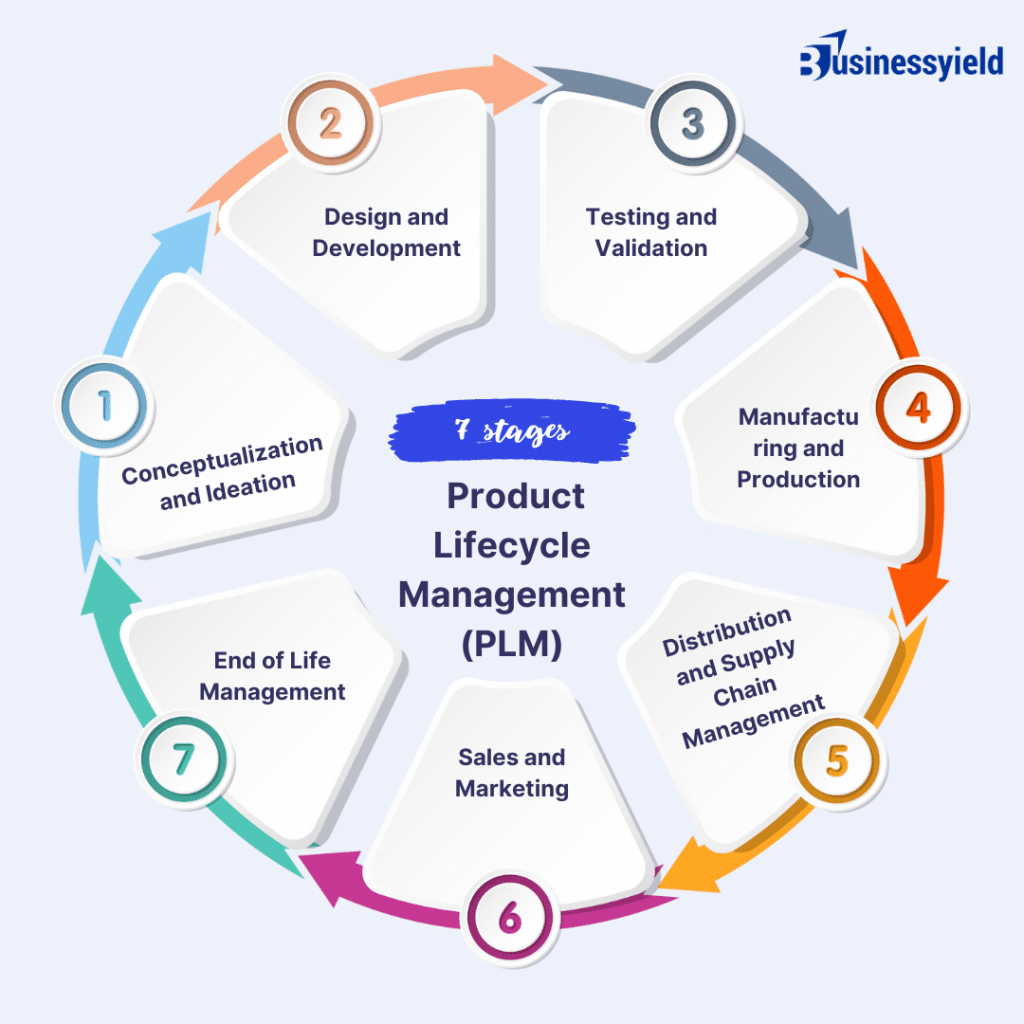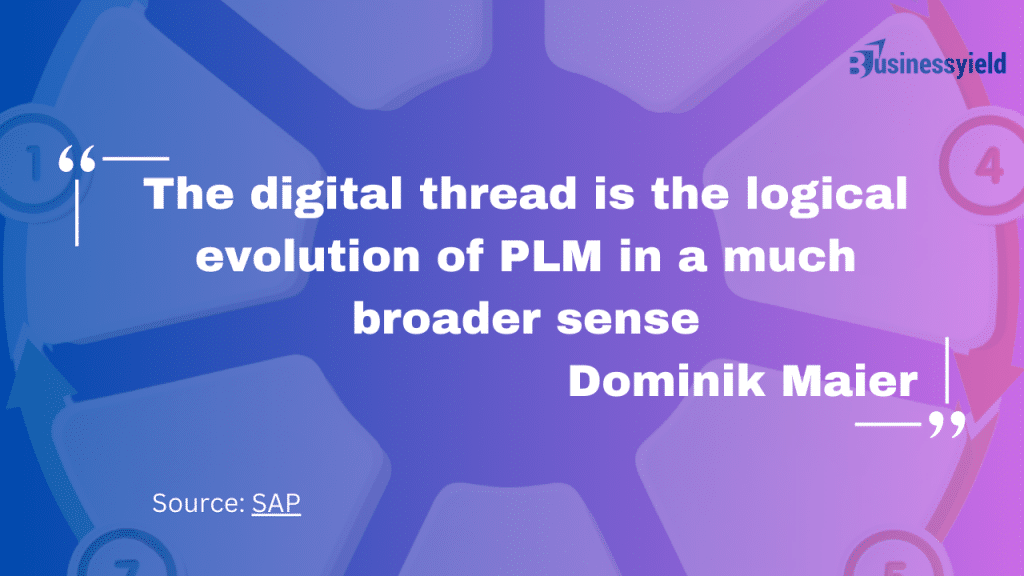The future of product lifecycle management is here!! Product lifecycle management (PLM) changed in 2024 due to market demands and technology. As a longtime professional, I’ve seen PLM evolve and firms adjust to stay competitive. From AI-powered design to connected ecosystems, dive into the top PLM trends reshaping the product development landscape in 2024. We’ll also discuss PLM’s dynamic changes and their effects on enterprises.
Understanding PLM

PLM is a strategic process that manages a product from conception to disposal using tools and methods. Working with varied teams and technologies has also shown me how PLM solutions streamline product development, promote collaboration, and foster creativity throughout.
PLM includes many tasks, including:
- Product Data Management (PDM): This centralizes product data, including CAD drawings, specifications, BOMs, and technical documentation. Managing design revisions and requirements during a big product launch was difficult for our team. A strong PDM system further centralized my organization’s data and improved collaboration, transforming our workflow.
- Collaboration and Workflow Management: This simplifies cross-functional team interactions, automates procedures, and provides stakeholders with current information to streamline workflows. While working on a difficult project with tight deadlines, efficient collaboration was crucial. Our PLM’s system collaboration features increased communication and project management.
- Change Management: This involves documenting, communicating, and implementing product design, specification, and requirement changes throughout the lifetime. However, managing change may be difficult, especially when priorities collide. We implemented changes easily and minimized interruptions by establishing explicit change management procedures and encouraging open communication.
- Quality management: This includes quality assurance, quality control, and following the rules to make sure the product is excellent and meets the requirements.
- Supply Chain Optimization: This entails putting together systems in the supply chain to get things, make them, and get them to customers more quickly and cheaply.
- Lifetime analysis and reporting: Analyzing product lifetime data to identify performance trends, improve performance, and guide decision-making.
PLM further helps your firm become more agile in today’s competitive business environment. Additionally, it improves development, collaboration, time-to-market, quality, and innovation, enhancing competitiveness and profitability.
READ ALSO: Product Lifecycle Management PLM: Detailed Guide to the PLM System
Evolution of PLM
The progress of PLM is astounding. PLM has evolved from a 1990s engineering data management tool into an enterprise solution. I’ve seen PLM evolve, integrate with multiple corporate systems, expand beyond engineering and design, and drive innovation and competitiveness during my career.
PLM has evolved through numerous stages:
- Early Adoption (1990s–2000s): PLM systems first managed engineering data like CAD drawings and requirements. While these systems streamlined design and development, they were limited and typically functioned in silos within businesses.
- Integration with ERP (2000s–2010s): Businesses realized the need to connect PLM with other corporate systems like ERP and CRM; hence, PLM became more integrated and interconnected. This integration further improved collaboration, data interchange, and product lifecycle insight across departments.
- Scope expansion (2010–present): Now covering the complete product lifetime from conceptualization to disposal, PLM has grown beyond engineering and design. Modern PLM systems improve collaboration, creativity, and product development by integrating people, processes, and technology. Because of Industry 4.0 innovations like IoT, AI, and additive manufacturing, businesses rely more on PLM.
PLM Trends in 2024
Product lifecycle management is rapidly integrating with cutting-edge technologies like IoT, AR, and additive manufacturing in Industry 4.0. These technologies provide integrated product lifecycle connectivity from concept to service. Companies now use IoT-enabled sensors to collect real-time data from field items, AR to visualize and model designs, and additive manufacturing to prototype and manufacture bespoke components quickly.
MarketsandMarkets, in a report published in 2019, projected a growth rate of the PLM market from USD 50.7 billion in 2019 to USD 73.7 billion at a CAGR of 7.8% during the forecast period.
#1. AI-Powered PLM Emergence

PLM is changing in 2024 because of numerous trends. AI is transforming decision-making, automating processes, and giving important insights. Being involved in AI-powered PLM initiatives has further shown me how these algorithms improve product development and efficiency. AI algorithms also look at big data sets, predict trends, and automate boring tasks. In essence, this helps businesses make smart choices, improve workflows, and cut down on time to market.
#2. Integration of GenAI
GenAI integration is reshaping how organizations approach product development within PLM systems. Its algorithms analyze vast datasets and autonomously generate design alternatives, optimizing product configurations and exploring innovative solutions.
By leveraging GenAI, organizations can further explore innovative solutions and optimize product configurations, ultimately enhancing product development efficiency and driving innovation. For example, Nike is leveraging AI-powered generative design to explore millions of shoe prototypes in minutes, leading to faster innovation and improved performance.
#3. Blockchain Integration in PLM
Adding blockchain technology is another trend that is changing things. This technology provides unmatched security, openness, and traceability throughout a product’s lifecycle. Blockchain-enabled solutions further boost trust, combat counterfeiting, and expedite compliance.
Key Benefits of Blockchain Integration in PLM
- Supply Chain Traceability: Blockchain makes it possible to track goods and parts from start to finish, ensuring they are real and come from the right place. This way, rules are followed, dangers are reduced, and fake goods are stopped.
- Protection of Intellectual Property: Blockchain also keeps safe records of intellectual property rights, ideas, and patents, showing who owns them and stopping others from stealing them. Additionally, it makes it easier to work together and make business deals.
- Product Authenticity and Fighting Counterfeiting: Using digital signatures allowed by blockchain, consumers can check the authenticity of a product. Hence. this builds trust and fights counterfeiting and gray market activities.
- Smart contracts for automated transactions: Blockchain-based smart contracts automate transactions within the PLM environment. Furthermore, this speeds up the licensing, contracting, and purchasing processes and lowers the risk of disputes and extra work.
- Data Security and Privacy: Blockchain also provides a decentralized, safe system for exchanging and saving private product data, keeping it safe from breaches and unauthorized access.
- Collaborative Product Development: Blockchain makes it safe for cross-functional teams, sellers, and partners to work together, which further increases trust, openness, and responsibility.
- Regulatory Compliance and Auditability: Blockchain also keeps a safe, unchangeable record of activities, audits, and licenses that are in line with regulations. This speeds up processes and lowers risks.
#4. IoT Integration
PLM now uses the IoT to provide real-time product performance and consumption data. Connected devices across the product lifecycle allow enterprises to gather data, monitor conditions, and proactively resolve concerns in 2024, improving product quality and customer satisfaction. Imagine a dashboard with real-time performance data driven by factory and product sensors. PLM immediately detects irregularities, enabling proactive responses and preventing costly difficulties.
READ ALSO: WHAT IS IOT: What Is It and How Does It Work?
IoT sensors embedded in products provide continuous data streams, allowing organizations to monitor usage patterns, identify potential issues, and enhance product performance throughout its lifecycle.
#5. Data Democratization
Data democratization in 2024 allows organizations to access, analyze, and exploit PLM data. Organizations eliminate silos and allow cross-functional teams to make real-time choices by democratizing data. Data democratization encourages cooperation, innovation, and agility, helping organizations adjust swiftly to changing market conditions and improve products throughout their lifetime.
Users across businesses may access, analyze, and apply data to make educated decisions using PLM data democratization. Breaking data boundaries and allowing various teams to collaborate fosters cooperation, innovation, and adaptation, leading to continual improvements and a competitive advantage in today’s fast-paced commercial world.
#6. Digital Thread Models

The introduction of digital thread models in 2024 is redefining how firms handle product information and processes in PLM systems. Digital thread models integrate product data and workflows across systems and stakeholders across the product lifecycle. Digital thread models give enterprises real-time visibility, traceability, and control over product-related operations by integrating design, production, and service. This integrated strategy increases cooperation, decision-making, and productivity, helping companies provide high-quality goods faster and cheaper.
PLM systems also use digital thread models to view product data and workflows holistically across the product lifecycle. Communication, decision-making, and productivity improve with digital thread models, allowing organizations to produce high-quality items faster and cheaper
#7. Digital Twin Technology
PLM uses digital twins to generate virtual versions of physical objects. Real-time product performance information from digital twins will enable predictive maintenance, remote monitoring, and simulation-based improvement in 2024. Organizations may improve product quality, downtime, and lifecycle costs with digital twins. For example, Siemens uses digital twins to virtually simulate the performance of wind turbines, facilitating remote collaboration and real-time troubleshooting across teams.
Digital twin technology lets companies mimic and monitor product performance in real-time. This provides predictive analytics, preventive maintenance, and product performance optimization over time.
#8. Regulatory Compliance
Higher industry standards are part of the evolving regulatory landscape. PLM systems in 2024 have extensive compliance and risk management functions to ensure regulatory compliance and mitigate product development and lifecycle management concerns. In addition, PLM solutions help firms traverse complicated regulatory environments with regulatory tracking, documentation management, audit trails, and compliance reporting.
PLM systems enable regulatory compliance by giving visibility into regulatory changes, automating compliance processes, and easing documentation and reporting to regulatory bodies.
#9. E-Commerce Platform Integration
PLM systems are connecting with e-commerce platforms to streamline product information management and order fulfillment as online and DTC sales grow. PLM technologies integrate with e-commerce platforms in 2024, letting companies centrally manage product catalogs, pricing, inventory, and order fulfillment. This integration streamlines DTC sales and guarantees product uniformity across channels.
PLM integration with e-commerce platforms streamlines product data management, optimizes order fulfillment, and provides a smooth online shopping experience.
#10. Sustainable PLM Practices
Sustainability will be included in PLM techniques in 2024. Businesses are using eco-friendly materials, designs, and production methods as they care more about the environment. Sustainability measurements and tools in PLM systems examine and optimize product environmental footprints throughout their lifecycle.
Responsible PLM reduces resource consumption, waste, and environmental effects across the product lifetime, from design and manufacture to distribution and disposal.
- Tracking and optimizing resources Track material usage and carbon footprints across the value chain to make sustainable sourcing and production decisions. Imagine maximizing resource use and avoiding waste.
- Track materials and components for ethical product disposal and recycling. A circular economy reduces environmental impact and enables closed-loop resource management.
- Design for Sustainability: Start PLM with sustainability concepts. Create items with low environmental effects and easy recycling. Imagine making items for centuries.
#11. Cloud-Based PLM Solutions
Cloud computing has altered PLM deployment and access. In 2024, cloud-based PLM solutions have become popular for their scalability, accessibility, and collaboration. This move also frees enterprises from old limits and facilitates worldwide collaboration. For example, Dassault Systèmes’ 3DEXPERIENCE platform facilitates real-time collaboration between engineers, designers, and suppliers across locations.
Cloud-based PLM solutions offer flexibility, allowing organizations to scale resources based on demand, access data from anywhere, and promote real-time collaboration among distributed teams.
Today’s cloud PLM offers:
- Enhanced Security: Robust encryption, access controls, and regular security audits ensure your sensitive product data is safe and sound. Cloud providers adhere to rigorous industry standards and compliance certifications, surpassing traditional on-premise solutions.
- Scalability & accessibility: Cloud deployment facilitates remote collaboration and global product development. Teams can access PLM from anywhere, anytime, on any device. Imagine seamless collaboration across continents and time zones.
- Continuous Innovation: Cloud providers constantly update platforms with the latest functionalities and security patches. You benefit from cutting-edge technology without the burden of managing updates and infrastructure. Imagine perpetual access to the latest advancements in PLM.
#12. Augmented Reality and Virtual Reality
Augmented and virtual reality offer immersive product design, development, and maintenance experiences in PLM. AR applications will improve visualization, virtual prototyping, and training in 2024, changing how companies view and use their products.
AR technology helps customers visualize and interact with product models, speeding up design reviews, assembly, and maintenance.
#13. Quality Management Focus
Quality management has become more important in PLM in 2024. Companies are stressing quality throughout the product lifecycle due to increased customer expectations and regulatory obligations. PLM solutions include quality planning, inspection, testing, and non-conformance management systems. By employing strong quality management practices, companies can further ensure products satisfy the highest quality, reliability, and safety standards, improving customer satisfaction and brand reputation.
You might also like: QUALITY MANAGEMENT: Definition, Examples, and Systems
PLM systems enable quality management to ensure goods meet the highest standards throughout their lifecycle. Companies may improve customer happiness, cut expenses, and meet regulations using strong quality management practices.
#14. Data Security and Privacy

In a cyberattack-prone world, PLM solution implementers prioritize data security and privacy. To protect product data and IP in 2024, PLM solutions include strong security, encryption, and access controls. Companies follow GDPR and CCPA to protect customer data and trust.
Data security and privacy safeguard crucial product data and intellectual property from cyberattacks. Encryption, access limits, and compliance ensure data security and regulatory compliance in PLM solutions.
#15. Risk Management
The relevance of risk management in PLM processes is expanding in 2024. More firms are incorporating risk management into PLM systems to identify, assess, and mitigate product lifecycle risks. 2024 PLM systems involve rigorous risk management to mitigate regulatory compliance, supply chain interruptions, cybersecurity concerns, and market volatility.
PLMs assess and mitigate product lifecycle risks. Addressing risks early can reduce product development costs, assure regulatory compliance, and reduce risk.
Benefits of PLM
Organizations gain from PLM’s efficiency, cooperation, time-to-market, product quality, and regulatory compliance. PLM helps companies launch high-quality products faster and cheaper by centralizing product data, optimizing processes, and encouraging departmental and supply chain collaboration.
Challenges of PLM
PLM solutions have many benefits, but installing and utilizing them can be difficult for enterprises. Change resistance, legacy system integration, data security, and cultural obstacles are also common issues. These issues require strong leadership, change management, and continuous development.
I’ve faced change opposition and legacy system integration concerns in PLM. Despite these challenges, PLM’s transformative power has grown on me. Organizations may maximize PLM’s potential and expand sustainably in a changing environment by encouraging innovation, adopting new technology, and prioritizing continuous improvement.
What is the Future of PLM?
Better AI integration, blockchain for strong security, IoT for real-time insights, and sustainable practices will shape the future of PLM, encouraging new ideas, teamwork, and efficiency throughout the entire product lifetime.
Which is the Best PLM Software?
Siemens Teamcenter, Dassault Systèmes ENOVIA, and PTC Windchill are popular PLM software depending on business needs. The best option depends on the industry, company size, and characteristics.
Which Company is Leading the Market for PLM Software?
Due to many market niches and indicators, determining a PLM software “leader” is difficult. According to market share and revenue, Siemens and Dassault Systèmes are in first place, then PTC and SAP. The “best” option depends on your demands and industry.
What is Product Lifecycle Management (PLM)?
Product lifecycle management (PLM) is the strategic management of a product’s conception, design, production, usage, and disposal.
Embrace PLM’s Future
In conclusion, the future of product lifecycle management is now. Staying on top of trends, using cutting-edge technologies, and encouraging cooperation and creativity are crucial as we navigate PLM in 2024 and beyond. In today’s dynamic business climate, firms may streamline, innovate, and expand by embracing PLM’s shifting nature and using it as a strategic necessity.
- PLM SOFTWARE: Best Product Lifecycle Management Software Reviews & Comparison
- WINDCHILL SOFTWARE: Features, Functions, Pricing, and Differences
- PLM Tools: Top Product Management Tools List in 2023
- PRODUCT DEVELOPMENT LIFECYCLE: Definition, Process & Stages






